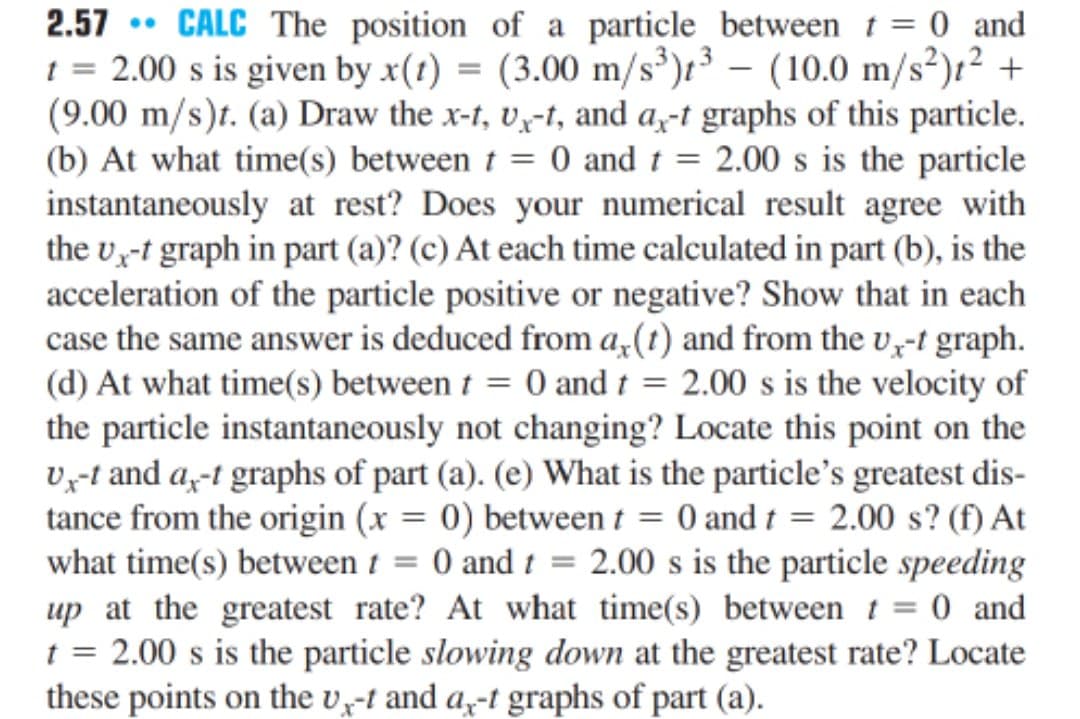2.57 • CALC The position of a particle between t = 0 and t = 2.00 s is given by x(t) = (3.00 m/s³)r³ – (10.0 m/s²)t² + (9.00 m/s)t. (a) Draw the x-t, v,-t, and a,-t graphs of this particle. (b) At what time(s) between t = 0 and t = 2.00 s is the particle instantaneously at rest? Does your numerical result agree with the v,-t graph in part (a)? (c) At each time calculated in part (b), is the acceleration of the particle positive or negative? Show that in each case the same answer is deduced from a,(1) and from the v,-t graph. (d) At what time(s) between 1 = 0 and t = 2.00 s is the velocity of the particle instantaneously not changing? Locate this point on the Vg-t and a,-t graphs of part (a). (e) What is the particle's greatest dis- tance from the origin (x = 0) between t = 0 and t = 2.00 s? (f) At what time(s) between t = 0 and t = 2.00 s is the particle speeding up at the greatest rate? At what time(s) between t = 0 and t = 2.00 s is the particle slowing down at the greatest rate? Locate these points on the v,-t and a,-t graphs of part (a).
2.57 • CALC The position of a particle between t = 0 and t = 2.00 s is given by x(t) = (3.00 m/s³)r³ – (10.0 m/s²)t² + (9.00 m/s)t. (a) Draw the x-t, v,-t, and a,-t graphs of this particle. (b) At what time(s) between t = 0 and t = 2.00 s is the particle instantaneously at rest? Does your numerical result agree with the v,-t graph in part (a)? (c) At each time calculated in part (b), is the acceleration of the particle positive or negative? Show that in each case the same answer is deduced from a,(1) and from the v,-t graph. (d) At what time(s) between 1 = 0 and t = 2.00 s is the velocity of the particle instantaneously not changing? Locate this point on the Vg-t and a,-t graphs of part (a). (e) What is the particle's greatest dis- tance from the origin (x = 0) between t = 0 and t = 2.00 s? (f) At what time(s) between t = 0 and t = 2.00 s is the particle speeding up at the greatest rate? At what time(s) between t = 0 and t = 2.00 s is the particle slowing down at the greatest rate? Locate these points on the v,-t and a,-t graphs of part (a).
Principles of Physics: A Calculus-Based Text
5th Edition
ISBN:9781133104261
Author:Raymond A. Serway, John W. Jewett
Publisher:Raymond A. Serway, John W. Jewett
Chapter2: Motion In One Dimension
Section2.1: Average Velocity
Problem 2.1QQ: Under which of the following conditions is the magnitude of the average velocity of a particle...
Related questions
Concept explainers
Question
Show given, unknown, drawing, formula, solution, and enclosed the final answer with unit. Any answer will do

Transcribed Image Text:2.57
CALC The position of a particle between t = 0 and
1 = 2.00 s is given by x(1) = (3.00 m/s³);³ – (10.0 m/s²)r² +
(9.00 m/s)t. (a) Draw the x-t, v,-t, and a,-t graphs of this particle.
(b) At what time(s) between t = 0 and t = 2.00 s is the particle
instantaneously at rest? Does your numerical result agree with
the v,-t graph in part (a)? (c) At each time calculated in part (b), is the
acceleration of the particle positive or negative? Show that in each
case the same answer is deduced from a,(t) and from the v,-t graph.
(d) At what time(s) between t = 0 and t = 2.00 s is the velocity of
the particle instantaneously not changing? Locate this point on the
vy-t and a,-t graphs of part (a). (e) What is the particle's greatest dis-
tance from the origin (x = 0) between t = 0 and t = 2.00 s? (f) At
what time(s) between 1 = 0 and 1 = 2.00 s is the particle speeding
up at the greatest rate? At what time(s) between t = 0 and
t = 2.00 s is the particle slowing down at the greatest rate? Locate
these points on the v-t and a,-t graphs of part (a).
|
Expert Solution
This question has been solved!
Explore an expertly crafted, step-by-step solution for a thorough understanding of key concepts.
This is a popular solution!
Trending now
This is a popular solution!
Step by step
Solved in 6 steps with 3 images

Knowledge Booster
Learn more about
Need a deep-dive on the concept behind this application? Look no further. Learn more about this topic, physics and related others by exploring similar questions and additional content below.Recommended textbooks for you

Principles of Physics: A Calculus-Based Text
Physics
ISBN:
9781133104261
Author:
Raymond A. Serway, John W. Jewett
Publisher:
Cengage Learning

Physics for Scientists and Engineers, Technology …
Physics
ISBN:
9781305116399
Author:
Raymond A. Serway, John W. Jewett
Publisher:
Cengage Learning

Principles of Physics: A Calculus-Based Text
Physics
ISBN:
9781133104261
Author:
Raymond A. Serway, John W. Jewett
Publisher:
Cengage Learning

Physics for Scientists and Engineers, Technology …
Physics
ISBN:
9781305116399
Author:
Raymond A. Serway, John W. Jewett
Publisher:
Cengage Learning